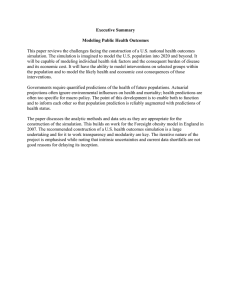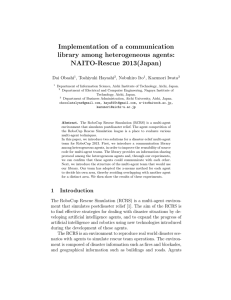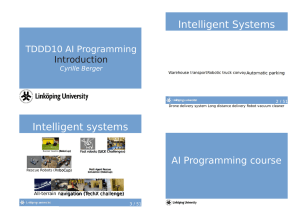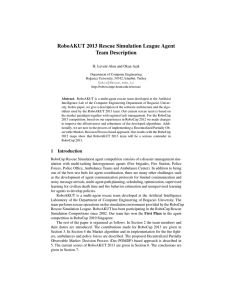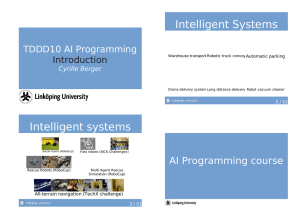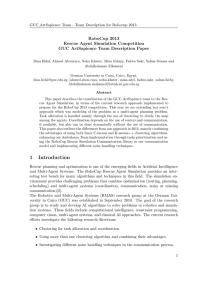The RoboCup Rescue Simulation Platform Cameron Skinner Sarvapali Ramchurn
advertisement
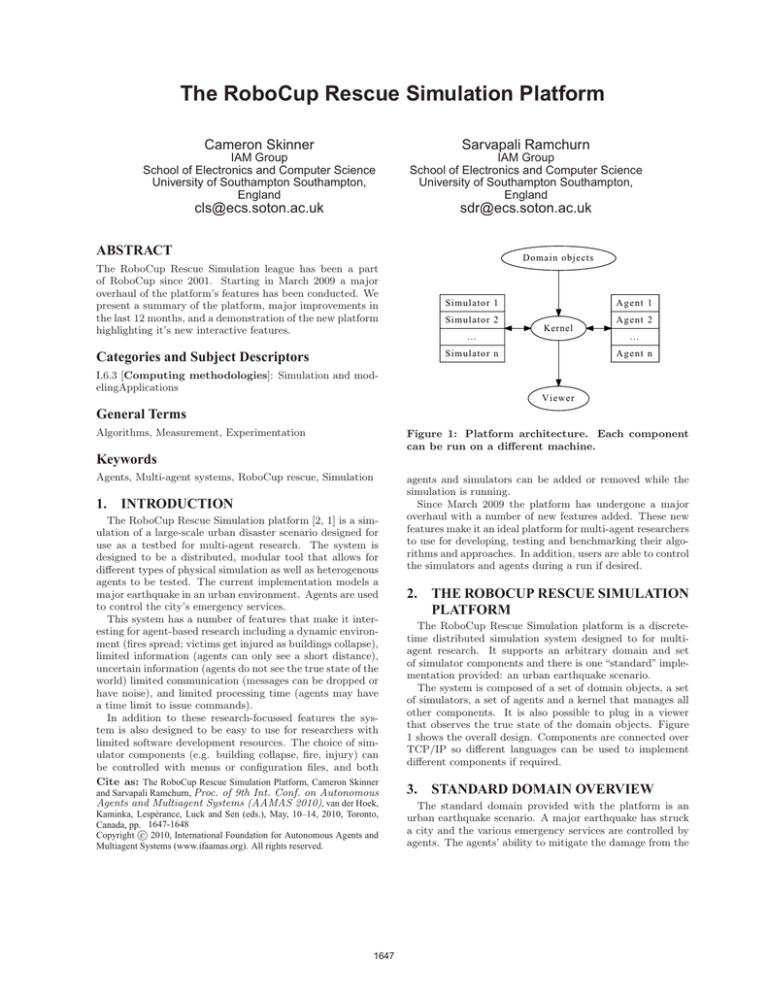
The RoboCup Rescue Simulation Platform Cameron Skinner Sarvapali Ramchurn IAM Group School of Electronics and Computer Science University of Southampton Southampton, England IAM Group School of Electronics and Computer Science University of Southampton Southampton, England cls@ecs.soton.ac.uk sdr@ecs.soton.ac.uk ABSTRACT , V The RoboCup Rescue Simulation league has been a part of RoboCup since 2001. Starting in March 2009 a major overhaul of the platform’s features has been conducted. We present a summary of the platform, major improvements in the last 12 months, and a demonstration of the new platform highlighting it’s new interactive features. < Categories and Subject Descriptors < < % I.6.3 [Computing methodologies]: Simulation and modelingApplications A % @! General Terms Algorithms, Measurement, Experimentation Figure 1: Platform architecture. Each component can be run on a different machine. Keywords Agents, Multi-agent systems, RoboCup rescue, Simulation 1. INTRODUCTION The RoboCup Rescue Simulation platform [2, 1] is a simulation of a large-scale urban disaster scenario designed for use as a testbed for multi-agent research. The system is designed to be a distributed, modular tool that allows for different types of physical simulation as well as heterogenous agents to be tested. The current implementation models a major earthquake in an urban environment. Agents are used to control the city’s emergency services. This system has a number of features that make it interesting for agent-based research including a dynamic environment (fires spread; victims get injured as buildings collapse), limited information (agents can only see a short distance), uncertain information (agents do not see the true state of the world) limited communication (messages can be dropped or have noise), and limited processing time (agents may have a time limit to issue commands). In addition to these research-focussed features the system is also designed to be easy to use for researchers with limited software development resources. The choice of simulator components (e.g. building collapse, fire, injury) can be controlled with menus or configuration files, and both Cite as: * * < ; # <3 < * # Proc. of 9th Int. Conf. on Autonomous Agents and Multiagent Systems (AAMAS 2010)# :3# A 3 # BC # B3 < # . # DEF# %DD# # # 1647-1648 c %DD# $ H . < !!! 1647 agents and simulators can be added or removed while the simulation is running. Since March 2009 the platform has undergone a major overhaul with a number of new features added. These new features make it an ideal platform for multi-agent researchers to use for developing, testing and benchmarking their algorithms and approaches. In addition, users are able to control the simulators and agents during a run if desired. 2. THE ROBOCUP RESCUE SIMULATION PLATFORM The RoboCup Rescue Simulation platform is a discretetime distributed simulation system designed to for multiagent research. It supports an arbitrary domain and set of simulator components and there is one “standard” implementation provided: an urban earthquake scenario. The system is composed of a set of domain objects, a set of simulators, a set of agents and a kernel that manages all other components. It is also possible to plug in a viewer that observes the true state of the domain objects. Figure 1 shows the overall design. Components are connected over TCP/IP so different languages can be used to implement different components if required. 3. STANDARD DOMAIN OVERVIEW The standard domain provided with the platform is an urban earthquake scenario. A major earthquake has struck a city and the various emergency services are controlled by agents. The agents’ ability to mitigate the damage from the earthquake is a useful metric for benchmarking multi-agent algorithms. Domain objects The earthquake scenario has three main types of domain object representing buildings, the road network and humans in the city. Buildings contain information about the structure’s size, footprint, construction material and flammability. The road network is a graph of connected road segments with a certain width and information about blockages on the road caused by debris from the earthquake. Humans are divided into civilians and emergency services. Both have information about their position, injuries and whether they are trapped in rubble. Agent actions Three branches of the emergency services are modelled: fire brigades, police officers and ambulances. These agents are primarily responsible for, respectively, extinguishing fires, clearing blocked roads and rescueing trapped or injured civilians. Agents can issue commands to the simulation server to move, extinguish a fire, clear a blocked road, rescue, load or unload a civilian or send a message to another agent. These commands may be fully or partially executed. For example, if an agent issues a command to move a long distance then the movement simulator might only execute a small part of that plan. Communication and perception The platform supports “pluggable” communication and perception. Different models for each can be chosen or implemented by the user depending on their research goals. The standard package includes a communication model based on radio channels that supports limited bandwidth, limited reception capability and various models of radio noise. 4. MAJOR NEW FEATURES The core of the system has been redesigned to make it easy to extend. New domains can be added by implementing the domain objects as Java objects. Existing simulators will simply ignore any domain objects they do not understand. Configuration has been standardised so that the kernel, simulators and agents can share a single configuration. The kernel can also send configuration information to simulators and agents running on different machines. The configuration can be edited at startup or even during a simulation run. Implementations of human-controlled agents have been created to allow users to interact with the simulation. The new architecture is more “pluggable” than earlier versions. Figure 2 shows a new perception component in use. A demonstration of these new features is available at http://roborescue.sf.net/demo/. 5. OPEN RESEARCH PROBLEMS There are a number of multi-agent research problems that can be investigated using the standard package. Researchers can choose which aspects of the system they are interested in investigating and use standard components for others. Task allocation with uncertainty A core part of the standard scenario is allocating tasks to agents. At any point in time there will be a number of fires, injured or buried civilians and blocked roads. The agents will 1648 Figure 2: Screenshot of a new perception component. know about some subset of these tasks but probably not all. Decisions must therefore be made about whether to search for new tasks, and how to allocate tasks given that new tasks may appear at any time. Coalition formation Coalitions of agents are generally required for efficient allocation in the earthquake domain. Civilians trapped in building rubble will generally require the combined efforts of several ambulances to be rescued before they die of their injuries. Co-operation The earthquake scenario generally requires different types of agents to cooperate. For example, the roads leading to an injured civilian or the hospital may be blocked and must be cleared by police before an ambulance can get to the target. Similarly, decisions about which fires to extinguish first may depend on the presence of nearby injured civilians and ambulances. Distributed vs centralized control Because communication is limited there will be a trade-off between centralized and distributed control. A centralized controller may have a more complete picture of the whole situation, but with unreliable communication it may not be able to send commands to remote agents. Communication With the radio channel model of communication it is possible for agents to choose their own communication structure, possibly even changing it on the fly. Researchers can also implement their own communication models if desired. 6. CONCLUSION The RoboCup Rescue Simulation platform provides a distributed simulation environment for conducting multi-agent research. The platform provides a rich, complex environment, in the form of an urban earthquake scenario, that highlights several open problems in multi-agent research. Researchers can choose which elements of the simulation they are interested in and can use standard implementations for those parts that are not of interest. 7. REFERENCES [1] Robocup rescue simulation project. http://www.sf.net/projects/roborescue, January 2010. [2] H. Kitano, S. Tadokoro, I. Noda, H. Matsubara, T. Takahashi, A. Shinjou, and S. Shimada. Robocup rescue: Search and rescue in large-scale disaster as a domain for autonomous agent research. In Proc. of 1999 IEEE International Conference on Systems, Man, and Cybernetics, pages 739–743, 1999.


